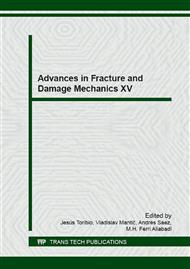p.46
p.50
p.54
p.58
p.62
p.66
p.70
p.74
p.78
Experimental-Numerical Assessment of Critical SIF from VHCF Tests
Abstract:
The continuous enhancement of reliability and durability requirements for many machinery components is significantly pushing the experimental research on the Very-High-Cycle Fatigue (VHCF) response of metallic materials. In order to significantly reduce testing time, ultrasonic testing machines are widely adopted when carrying out VHCF tests. Several fundamental material properties can be estimated from the fracture surfaces of specimens failed during ultrasonic VHCF tests. In the VHCF literature the critical Stress Intensity Factor (SIF) is generally estimated by applying analytical SIF formulations to the typical semi-circular surface crack geometry revealed by fracture surfaces at final failure. However, when subjected to ultrasonic VHCF tests, analytical SIF formulations valid for static loading conditions could eventually lead to significant estimation errors. The present paper aims at comparing the critical SIF at failure estimated from conventional analytical formulations and from Finite Element Models (FEMs). The fracture surfaces of two specimens with different shapes (Hourglass and Gaussian) are taken into account for modeling crack geometry at final failure. Through an implicit solving procedure, the critical SIF in resonance condition at 20 kHz is computed from the 3D geometry of the cracked specimens and compared with the corresponding analytical prediction.
Info:
Periodical:
Pages:
62-65
Citation:
Online since:
September 2016
Keywords:
Price:
Сopyright:
© 2016 Trans Tech Publications Ltd. All Rights Reserved
Share:
Citation:


